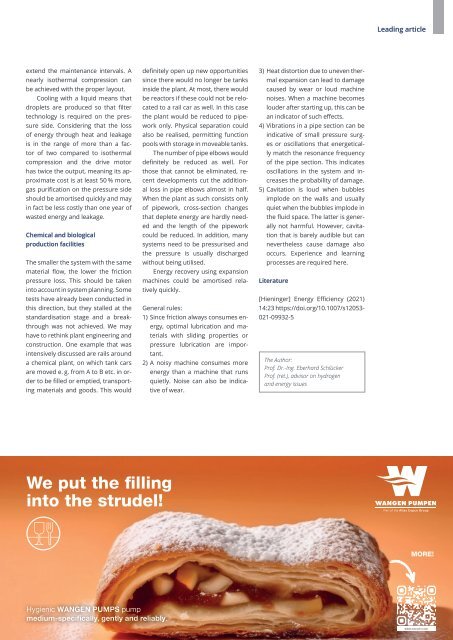PuK - Process Technology & Components 2024
A technical trade magazine with a history of more than 60 years.
A technical trade magazine with a history of more than 60 years.
You also want an ePaper? Increase the reach of your titles
YUMPU automatically turns print PDFs into web optimized ePapers that Google loves.
Leading article<br />
extend the maintenance intervals. A<br />
nearly isothermal compression can<br />
be achieved with the proper layout.<br />
Cooling with a liquid means that<br />
droplets are produced so that filter<br />
technology is required on the pressure<br />
side. Considering that the loss<br />
of energy through heat and leakage<br />
is in the range of more than a factor<br />
of two compared to isothermal<br />
compression and the drive motor<br />
has twice the output, meaning its approximate<br />
cost is at least 50 % more,<br />
gas purification on the pressure side<br />
should be amortised quickly and may<br />
in fact be less costly than one year of<br />
wasted energy and leakage.<br />
Chemical and biological<br />
production facilities<br />
The smaller the system with the same<br />
material flow, the lower the friction<br />
pressure loss. This should be taken<br />
into account in system planning. Some<br />
tests have already been conducted in<br />
this direction, but they stalled at the<br />
standardisation stage and a breakthrough<br />
was not achieved. We may<br />
have to rethink plant engineering and<br />
construction. One example that was<br />
intensively discussed are rails around<br />
a chemical plant, on which tank cars<br />
are moved e. g. from A to B etc. in order<br />
to be filled or emptied, transporting<br />
materials and goods. This would<br />
definitely open up new opportunities<br />
since there would no longer be tanks<br />
inside the plant. At most, there would<br />
be reactors if these could not be relocated<br />
to a rail car as well. In this case<br />
the plant would be reduced to pipework<br />
only. Physical separation could<br />
also be realised, permitting function<br />
pools with storage in moveable tanks.<br />
The number of pipe elbows would<br />
definitely be reduced as well. For<br />
those that cannot be eliminated, recent<br />
developments cut the additional<br />
loss in pipe elbows almost in half.<br />
When the plant as such consists only<br />
of pipework, cross-section changes<br />
that deplete energy are hardly needed<br />
and the length of the pipework<br />
could be reduced. In addition, many<br />
systems need to be pressurised and<br />
the pressure is usually discharged<br />
without being utilised.<br />
Energy recovery using expansion<br />
machines could be amortised relatively<br />
quickly.<br />
General rules:<br />
1) Since friction always consumes energy,<br />
optimal lubrication and materials<br />
with sliding properties or<br />
pressure lubrication are important.<br />
2) A noisy machine consumes more<br />
energy than a machine that runs<br />
quietly. Noise can also be indicative<br />
of wear.<br />
3) Heat distortion due to uneven thermal<br />
expansion can lead to damage<br />
caused by wear or loud machine<br />
noises. When a machine becomes<br />
louder after starting up, this can be<br />
an indicator of such effects.<br />
4) Vibrations in a pipe section can be<br />
indicative of small pressure surges<br />
or oscillations that energetically<br />
match the resonance frequency<br />
of the pipe section. This indicates<br />
oscillations in the system and increases<br />
the probability of damage.<br />
5) Cavitation is loud when bubbles<br />
implode on the walls and usually<br />
quiet when the bubbles implode in<br />
the fluid space. The latter is generally<br />
not harmful. However, cavitation<br />
that is barely audible but can<br />
nevertheless cause damage also<br />
occurs. Experience and learning<br />
processes are required here.<br />
Literature<br />
[Hieninger] Energy Efficiency (2021)<br />
14:23 https://doi.org/10.1007/s12053-<br />
021-09932-5<br />
The Author:<br />
Prof. Dr.-Ing. Eberhard Schlücker<br />
Prof. (ret.), advisor on hydrogen<br />
and energy issues<br />
We put the filling<br />
into the strudel!<br />
MORE!<br />
Hygienic WANGEN PUMPS pump<br />
medium-specifically, gently and reliably.

















